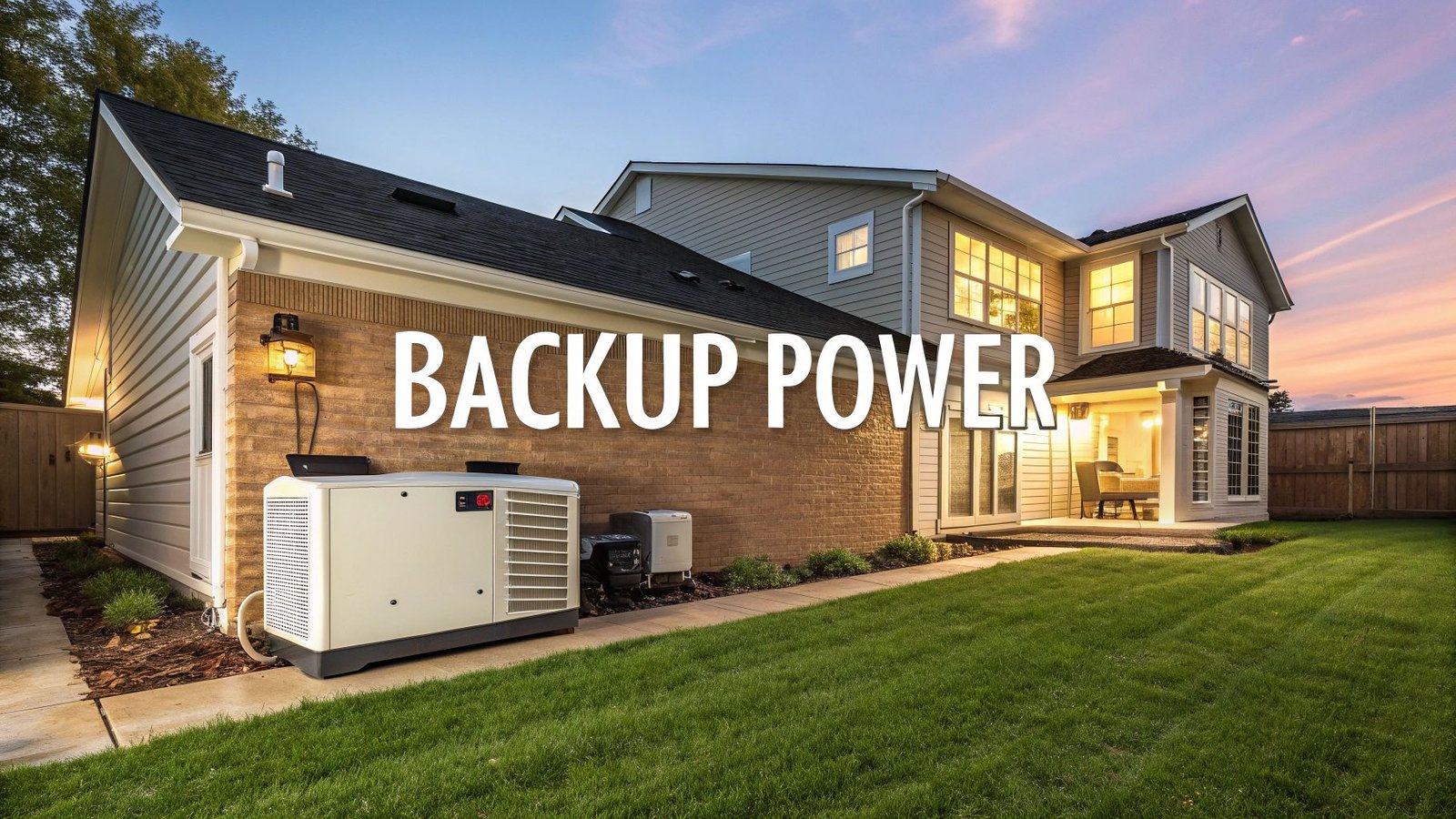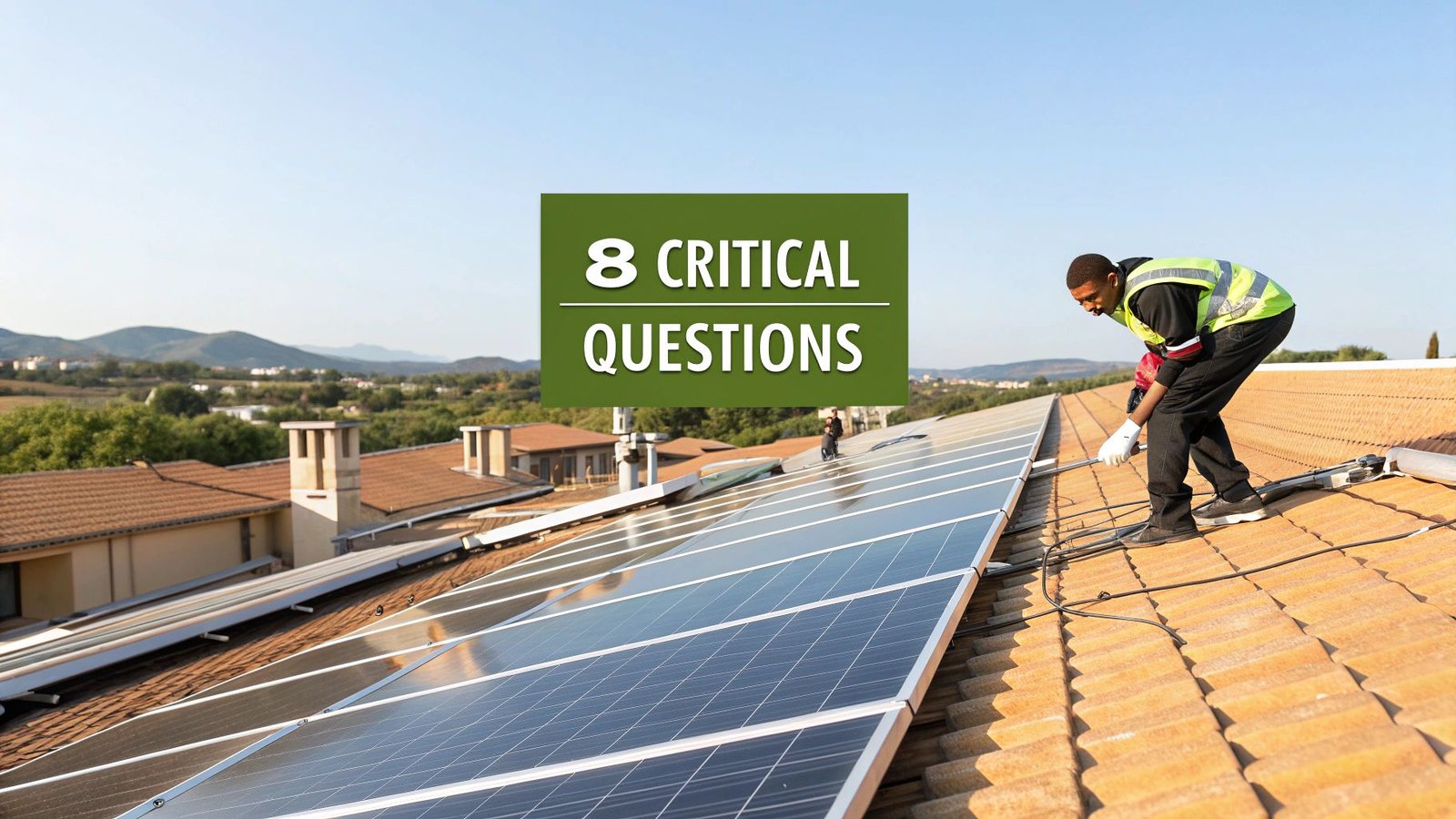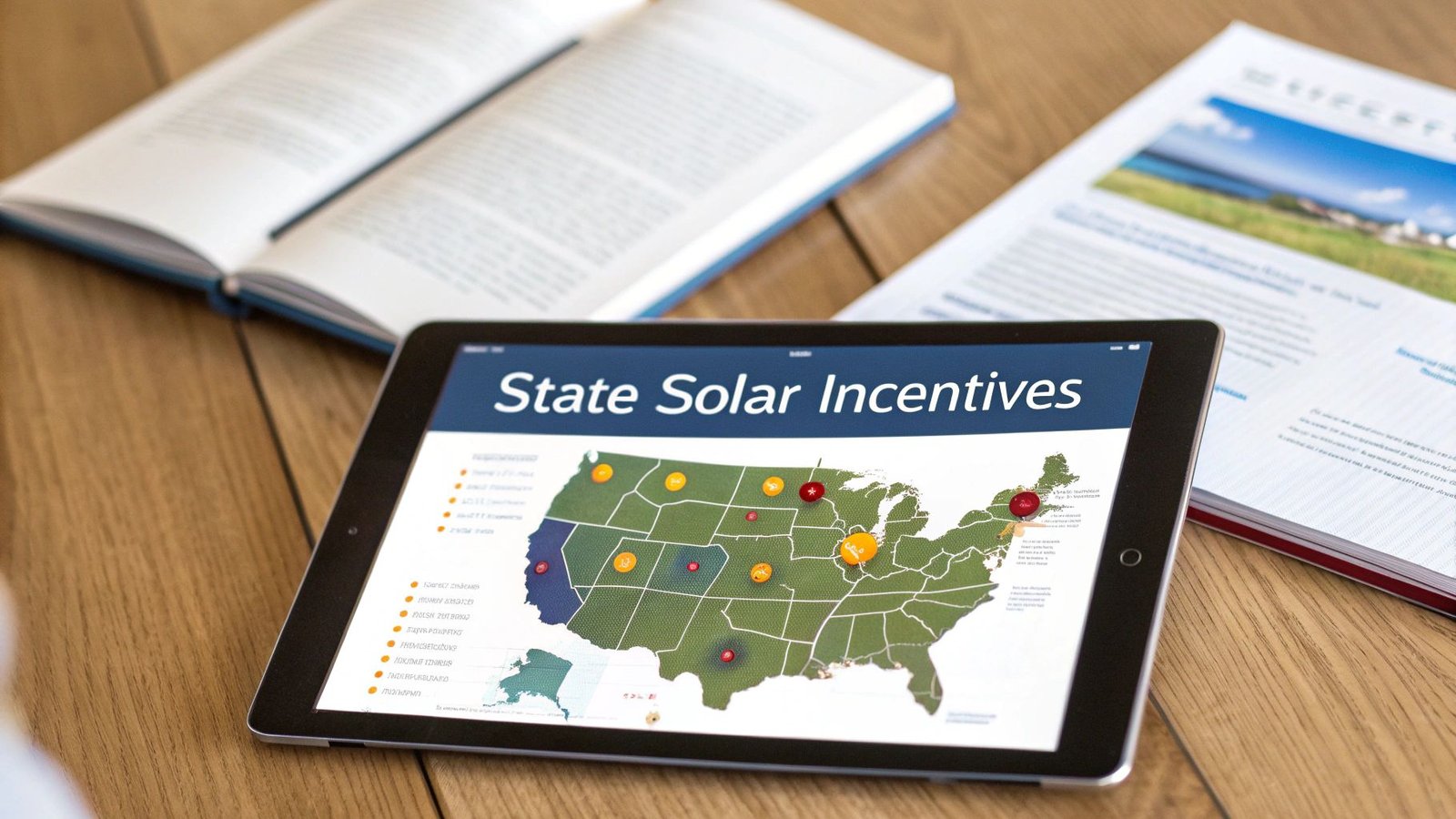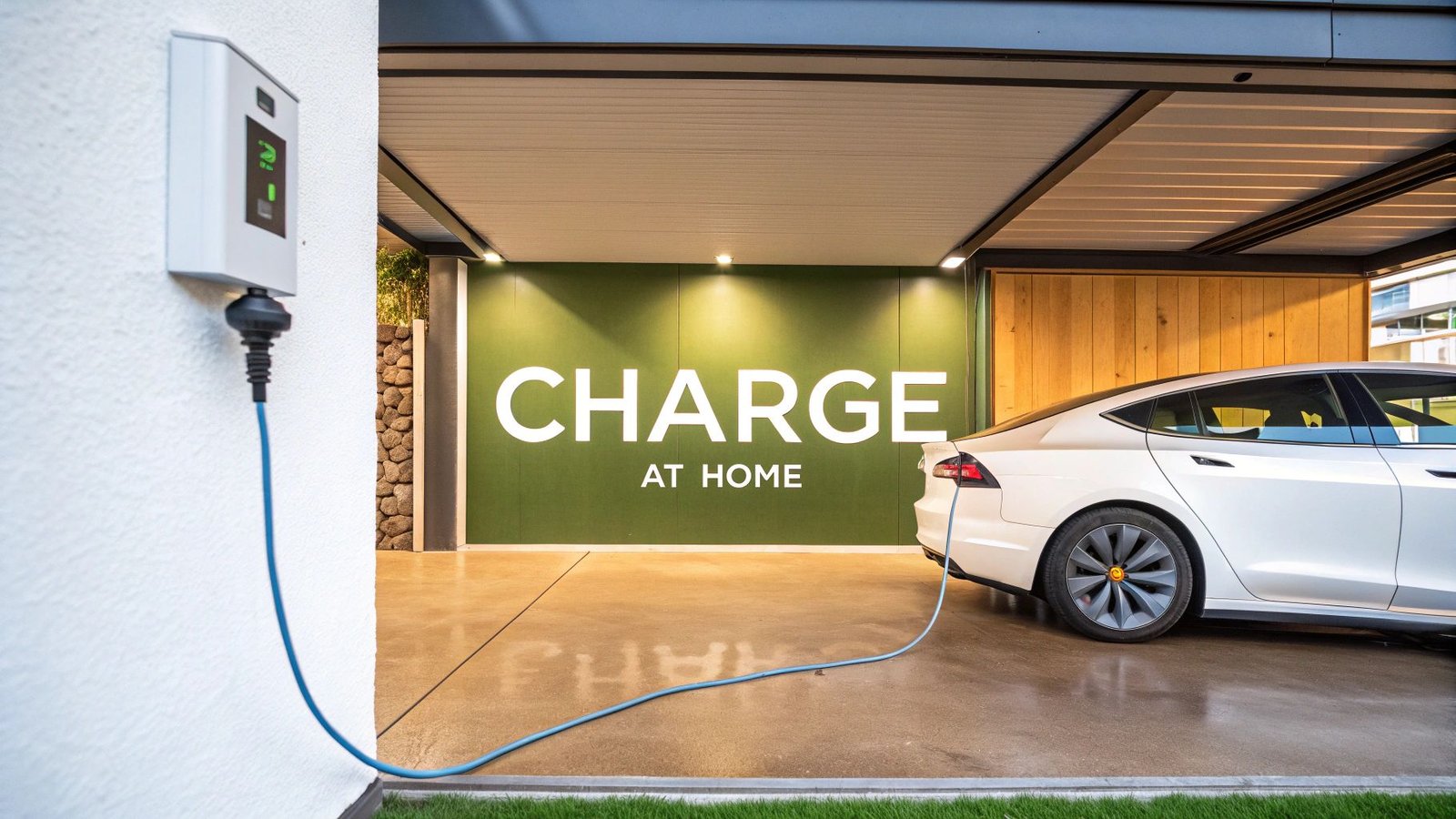When the power grid goes down, a home backup power solution kicks in, giving you a reliable source of electricity to keep your essential appliances and devices up and running. These systems can be anything from a simple portable generator for the basics to a sophisticated whole-home battery system that provides seamless, automatic protection.
Think of it as an insurance policy for your home’s electrical system—one that guarantees safety, comfort, and a bit of normalcy when an outage hits.
Why Backup Power Is No Longer a Luxury
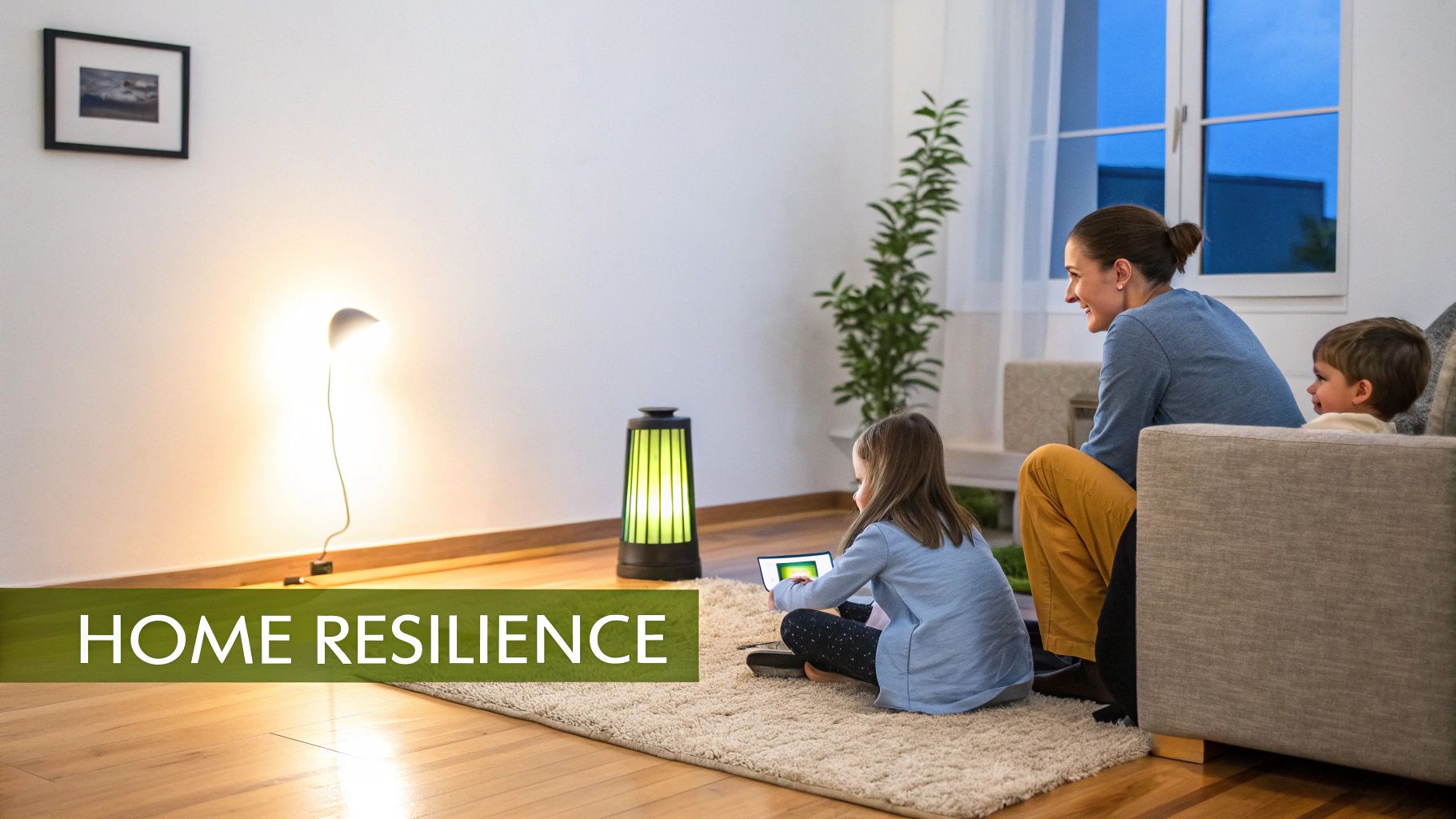
Picture this: you're at home when a storm rolls in, and suddenly, everything goes dark. The lights flicker out, the refrigerator's familiar hum stops, and the Wi-Fi router blinks off. In a flash, you're cut off from the outside world, and all the modern comforts you rely on are gone. This isn't a rare what-if scenario anymore; it's becoming a common reality.
We depend on a steady flow of electricity more than ever, yet our power grid is straining under the pressure. Between aging infrastructure and the increasing frequency of extreme weather, power outages are happening more often and lasting longer. That’s why having a backup power system has shifted from a nice-to-have convenience to a core part of home preparedness.
The Real Impact of a Power Outage
Losing power is more than just a minor inconvenience like not being able to watch TV. The ripple effects can be surprisingly serious, affecting your family's safety, your finances, and even your health.
Just think about the immediate consequences:
- Safety and Security: Your home security system, electric garage door opener, and even basic lighting all need power to function.
- Communication: Without electricity, you can't charge your phone or get online for critical emergency updates.
- Food Spoilage: A fridge can only stay cold for a few hours without power, potentially costing you hundreds of dollars in spoiled food.
- Comfort and Health: HVAC systems stop working in extreme heat or cold, and crucial medical equipment like CPAP machines will shut down.
This growing need is clearly reflected in the market. The global residential backup power market was valued at USD 11.10 billion in 2023 and is expected to nearly double, reaching USD 21.48 billion by 2032. That’s an annual growth rate of 7.64%, showing just how many homeowners are prioritizing their energy independence.
Residential Backup Power Market Growth (in Billion USD)
-------------------------------------------------------
2023: $11.10 |█████████████
|
|
|
|
2032: $21.48 |█████████████████████████
A Shift in Mindset
It's time to start seeing a backup power system as a critical home investment, not a luxury. It's about maintaining continuity for your family, whether you work from home, have vulnerable family members to care for, or simply want the peace of mind that comes with being prepared.
A reliable backup power system transforms your home into a sanctuary during a crisis, ensuring that when the grid goes down, your life doesn't have to stop with it.
Understanding the different types of emergency power supplies available is the first step toward making a smart decision. By preparing now, you're taking control and protecting your home and family from the growing uncertainty of an aging power grid.
Decoding Your Backup Power Options
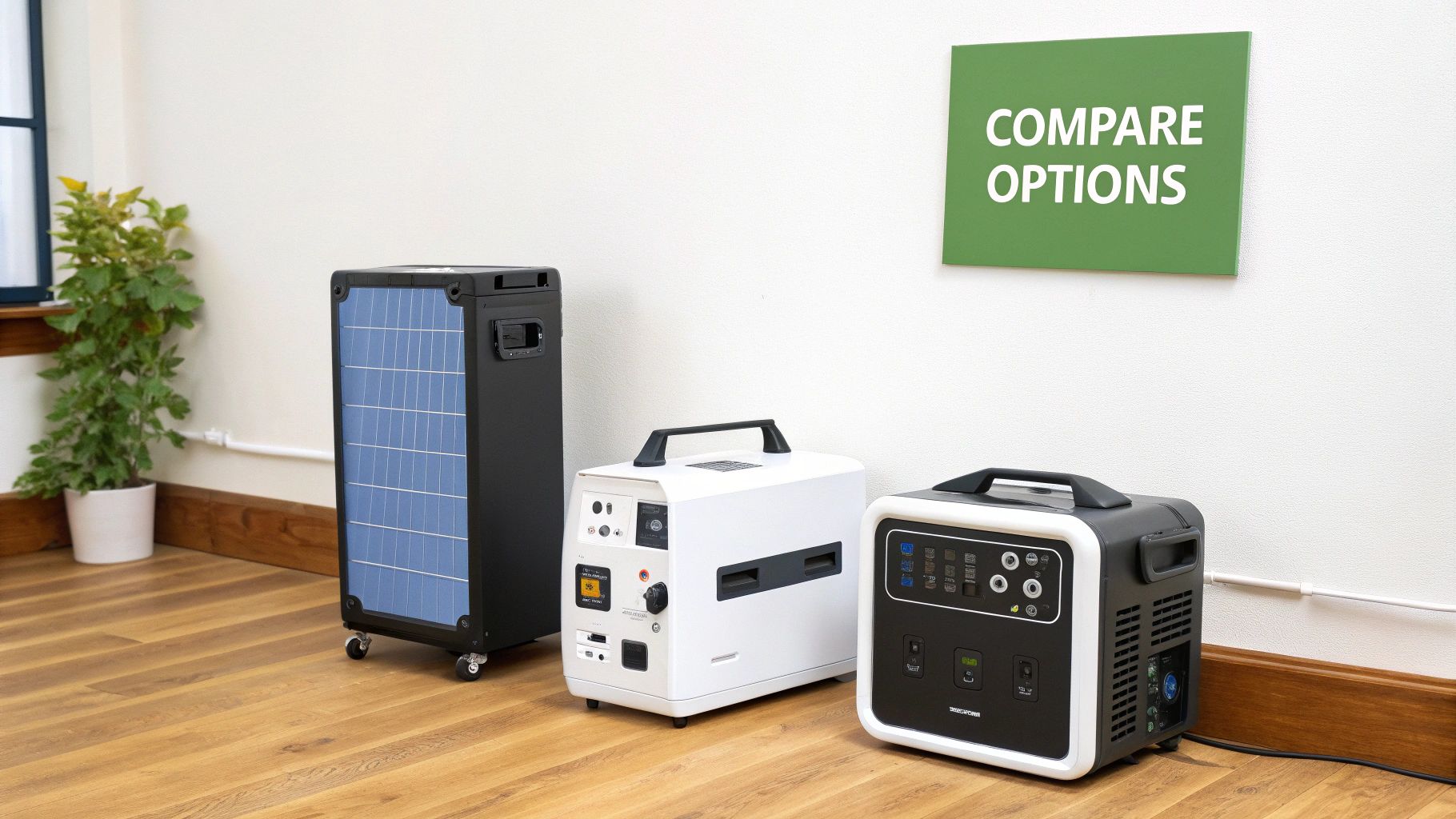
Choosing a home backup power solution can feel like learning a new language. You're suddenly hit with terms like "inverters," "transfer switches," and "watt-hours," and it's easy to get lost in the technical weeds.
But here’s the secret: finding the right system is really just about matching the technology to your lifestyle and what you truly need during an outage. Let's break down the main players in a way that makes sense.
The Versatile Power Toolkit: Portable Generators
You've probably seen these before. Portable generators are the most common and familiar type of backup power for a good reason. Think of them as a versatile toolkit you can pull out of the garage whenever you need a quick fix.
They're usually powered by gasoline, relatively affordable, and perfectly capable of handling a few essentials during a short power outage. You can keep your fridge running, power up a few lights, and charge your phones. But they demand a hands-on approach—you have to wheel them out, start them up, and keep an eye on the fuel. They're also noisy and must be operated well away from your home to prevent dangerous carbon monoxide buildup.
The Private Power Plant: Standby Generators
If a portable generator is a toolkit, then a standby generator is your home's very own private power plant. These are permanent installations, typically fueled by natural gas or propane, that are wired directly into your home's electrical panel.
Their killer feature? Automation. The moment the grid goes down, an automatic transfer switch senses the outage and fires up the generator in seconds. Power is restored to your entire house (or just the critical circuits you've chosen) without you lifting a finger. This seamless, hands-off protection is exactly why they're the top choice for homeowners who want total peace of mind, especially during extended outages.
This desire for robust, reliable power is a growing trend. The market for these systems was valued at around USD 5 billion in 2025 and is expected to grow at an impressive 15% compound annual rate, potentially hitting USD 15 billion by 2033. You can dig deeper into the market's trajectory and what's driving this growth in this full analysis of whole-home backup power system trends.
The Silent Guardian: Battery Systems and Solar Generators
Finally, we have battery systems, which often get paired with solar panels to create what's known as a solar generator. I like to think of these as the silent guardians of your home's power. Instead of burning fuel to create electricity on the spot, they store it for when you need it most.
These systems provide instant, silent backup power. They kick in so fast you probably won't even see the lights flicker. You can charge them from the grid (ideally during cheaper, off-peak hours) or, for true energy independence, from your own solar panels. It’s a clean, quiet, and renewable way to keep your home running. Learning how to store solar energy is the first step toward unlocking this potential.
A key advantage of battery storage is its ability to provide immediate, uninterrupted power. This makes it a perfect solution for protecting sensitive electronics and medical devices that cannot tolerate even a momentary loss of electricity.
Each of these home backup power solutions fills a different need. To help you see the differences more clearly, let's look at them side-by-side.
Comparing Home Backup Power Solutions at a Glance
This table offers a quick summary of the core features of each backup power type, helping you quickly spot which one might be the best fit for your home and priorities.
| Solution Type | Primary Use Case | Power Output | Fuel or Energy Source | Automation Level |
|---|---|---|---|---|
| Portable Generator | Short-term outages, powering select essentials, outdoor use. | Low to Medium (1-10 kW) | Gasoline, Propane | Manual |
| Standby Generator | Long-term outages, whole-home or critical circuit power. | High (10-22+ kW) | Natural Gas, Propane | Automatic |
| Battery System | Instant, seamless backup for essentials or whole home. | Varies (5-20+ kWh) | Grid, Solar Panels | Automatic |
As you can see, the right choice really comes down to balancing convenience, power needs, and budget.
Calculating Your Home's True Power Needs
https://www.youtube.com/embed/elte2DFumdo
Getting the right size for your home backup power system is probably the single most important decision you'll make. If you go too small, you'll be left in the dark when it can't handle your essential appliances. But if you go too big, you’re just throwing money away on power you'll never actually use.
The sweet spot is somewhere in the middle. Finding it all starts with a quick home energy audit—and don't worry, it’s not nearly as complicated as it sounds. It’s really just about making a smart list of what you absolutely must have running during an outage.
Running Watts vs. Starting Watts Explained
Before you start making that list, there’s a crucial concept you need to grasp: the difference between running watts and starting watts.
Think of it like trying to push a stalled car. It takes a massive initial shove to get it moving from a dead stop. That’s your starting watts. Once it’s rolling, though, it takes far less effort to keep it going. That’s your running watts.
Many of the big-ticket items in your home with motors—like your refrigerator, well pump, or air conditioner—work exactly the same way. They need a huge, momentary jolt of power to kick on.
That initial surge is the number that matters most. Your backup system has to be able to handle that peak demand, even if it only lasts for a split second. Overlooking starting watts is one of the most common mistakes people make, and it leads to a system that trips and fails right when you need it.
When sizing your backup power solution, you have to plan for the combined starting wattage of everything you might turn on at once. This is the only way to ensure your system can handle that initial power draw without failing.
Conducting Your Home Energy Audit
Alright, let's get down to business and figure out what your home actually needs. Grab a notepad or open a spreadsheet and make two columns: "Must-Haves" and "Nice-to-Haves."
-
List Your Must-Haves: Start by walking through your house and identifying the things that are completely non-negotiable in an outage. This usually includes the refrigerator, a few lights, any critical medical devices (like a CPAP machine), your internet router, and maybe a sump pump if you have a basement. These are your absolute priorities.
-
List Your Nice-to-Haves: Now, think about the things you’d like to have but could survive without. This could be the TV, microwave, coffee maker, or your central AC.
This simple exercise forces you to focus on what's truly essential, which is the secret to picking a home backup power solution that's both effective and affordable. Once you've got your list, it's time to add up the numbers. For a really deep dive into this, you can learn more about how to calculate your home's energy consumption to get a much more precise picture.
Wattage Needs for Common Household Appliances
To give you a head start, here's a table with some ballpark wattage figures for common appliances.
These are just estimates, of course. The best way to get accurate numbers is to check the manufacturer's label on your actual appliances, but this will give you a pretty good idea of what you're working with.
Wattage Needs for Common Household Appliances
| Appliance | Running Watts (Approximate) | Starting Watts (Approximate) |
|---|---|---|
| Refrigerator | 700 W | 2,200 W |
| Sump Pump (½ HP) | 1,050 W | 2,150 W |
| Central AC (10,000 BTU) | 1,500 W | 4,500 W |
| Electric Water Heater | 4,500 W | 4,500 W |
| Lights (LED Bulbs x5) | 50 W | 50 W |
| CPAP Machine | 60 W | 100 W |
| Internet Router/Modem | 10 W | 10 W |
| Television | 150 W | 150 W |
| Microwave | 1,000 W | 1,000 W |
By adding up the starting watts for your essential items, you'll get a solid baseline for the minimum power your backup system needs. This simple calculation is your first real step toward peace of mind and energy security.
Generators Versus Battery Systems Compared

When it comes to backup power, you're essentially looking at two very different paths: generators and battery systems. This is one of the biggest decisions you'll make. And while they both keep your lights on when the grid goes down, how they get there couldn't be more different. It's not just a tech choice; it’s about what fits your lifestyle.
Think of it this way: a generator is like having a tiny, personal power plant in your backyard. It burns fuel to actively make electricity on the spot. A battery system is more like a personal energy reservoir—it stores power from another source (like solar panels or the grid) and holds it until you need it.
Let's get past a simple pros-and-cons list and really dig into what matters day-to-day.
The Financial Equation: Upfront Cost Versus Long-Term Value
The first thing most people look at is the price tag, and the difference is pretty stark. Portable generators are definitely the cheapest way to get started, making them a popular choice for handling basic, short-term outages. Standby generators are a much bigger investment, but they offer the convenience of automated, whole-home power.
Home battery systems usually carry the highest initial cost, especially if you're pairing them with solar panels to achieve true energy independence. But the story doesn't stop there. With a generator, you have to factor in the ongoing costs of fuel, regular maintenance like oil changes, and the occasional repair. Those costs add up fast.
Over a 10-year lifespan, the fuel and maintenance for a standby generator can easily add thousands of dollars to its total cost. In contrast, battery systems have almost no maintenance and can be charged for free with solar energy, often making them the more affordable option in the long run.
Daily Life Impact: Noise, Fumes, and Footprint
How a backup system actually feels to live with is just as important as how much power it provides. Let's be honest: generators are loud. A standby unit can be as noisy as a lawnmower, which gets old fast during a long outage—for both you and your neighbors.
They also pump out exhaust fumes, which means you have to be very careful about placement to avoid carbon monoxide dangers. Battery systems, on the other hand, are completely silent. That makes them a perfect fit for suburbs, townhomes, or any situation where peace and quiet are a priority. If you're powering sensitive medical equipment, silent operation is non-negotiable. Our guide on battery backup systems for homes dives deeper into these real-world benefits.
Here’s a quick rundown of the key differences:
| Feature | Generators (Standby & Portable) | Battery Systems |
|---|---|---|
| Noise Level | Loud (60-80+ dB) | Silent (<30 dB) |
| Emissions | Produces CO and other fumes | Zero emissions during operation |
| Ongoing Costs | Fuel (gas/propane), oil changes | Minimal; potential grid charging costs |
| Power Delivery | Slight delay before power restores | Instantaneous and seamless |
| Energy Source | Fossil fuels | Grid or renewable energy (solar) |
Installation and Maintenance Realities
The setup process is another area where these two systems diverge. A portable generator is simple—just wheel it out and plug in your extension cords. A standby generator is a whole different ballgame, requiring a professional electrician and a plumber to hook it up to your home's electrical panel and fuel line. It's a complex job that usually requires permits.
Battery systems also need a professional installation, but they are generally easier to integrate with your existing electrical setup. When it comes to upkeep, the difference is night and day. Generators are engines. They need regular tune-ups, oil checks, and fuel treatments to make sure they'll actually start when you need them most. Batteries are solid-state tech with no moving parts, so they require basically zero maintenance from you.
This push for more convenient, "set it and forget it" power is fueling huge growth in the market. The global backup power market hit USD 19.5 billion in 2023 and is expected to climb to USD 31.7 billion by 2032. This isn't just a trend; it's a clear signal that homeowners are looking for smarter, more reliable energy solutions, as detailed in this comprehensive market analysis.
Ultimately, the best choice really comes down to your specific needs. Are you in a rural area facing multi-day outages, or a suburban home needing silent, instant power for critical devices? Your answer will point you in the right direction.
Looking Beyond the Sticker Price: What's the Total Cost?
When you’re shopping for a home backup power system, the price tag you see first is just the tip of the iceberg. To really understand what you're getting into financially, you need to think about the Total Cost of Ownership (TCO). This means looking at every single expense from the day you buy it until the day you replace it.
Thinking this way from the start saves you from nasty financial surprises later on. The initial purchase is a big one, for sure. But it's the hidden, ongoing costs that often make one system a bargain and another a money pit over time.
Breaking Down the Full Investment
Let's unpack all the costs involved so you can compare your options apples-to-apples. Every system has a different mix of expenses, and seeing them laid out makes the real price much clearer.
Here’s what you need to budget for:
- Initial Equipment Purchase: This is the straightforward cost of the generator or battery unit.
- Professional Installation: This is a big one for standby generators and home batteries. You're paying for electricians, permits, and maybe even a plumber to run a gas line.
- Ongoing Fuel Costs: This is the generator's Achilles' heel. Every hour it runs, it’s burning through gasoline, propane, or natural gas, and that bill adds up fast.
- Routine Maintenance: Generators are like cars—they need regular oil changes, filter replacements, and check-ups to stay reliable.
- Potential Permit Fees: Your local town or county will likely require permits for any permanently installed system, adding another line item to the budget.
The total cost of ownership gives you the real story. A system that seems cheaper upfront can easily end up costing you more in the long run once you factor in fuel and maintenance.
Generator vs. Battery: Where Does the Money Go?
So, how do these costs play out when comparing the two most popular whole-home solutions? Seeing them side-by-side really highlights the long-term financial differences.
Total Cost of Ownership Comparison (10-Year Estimate)
------------------------------------------------------
Standby Generator:
Upfront Cost |█████████████
Installation |█████████
Fuel (10 yrs) |███████████████████
Maintenance |███████
Home Battery System:
Upfront Cost |████████████████████████
Installation |██████████
Fuel (10 yrs) |(none)
Maintenance |█
Key: Each '█' represents a portion of the total cost.
Home battery systems, especially when you pair them with solar panels, have a hefty initial price tag. There's no getting around that. But once they're installed, their running costs are practically zero. If you're serious about this route, a deep dive into understanding the cost of solar battery backup is a must-read.
By taking the time to weigh all these factors, you can create a realistic budget and pick a system that you can actually afford to own and run for years. This bigger-picture approach ensures your investment in peace of mind is one you won't regret.
How to Make Your Final Decision
Alright, you've waded through the technical specs and now it's time for the most important part: picking the right home backup power solution for you. This is where we balance your actual needs, your budget, and what you want for the long haul. Think of this as your final action plan to get from "thinking about it" to "ready for anything."
Before you start comparing models or getting quotes, the first step is a little self-assessment. You need a really clear picture of what you expect this system to do. Answering a few straightforward questions will immediately shrink your list of options and, more importantly, stop you from paying for power or features you’ll never use.
A Checklist for Clarity
To help you sort it all out, run through this simple checklist. The more honest you are here, the better your final decision will be.
- What's the main goal? Are you just trying to keep the essentials running—like the fridge, some lights, and the Wi-Fi—or do you want to live life as normal with seamless, whole-home coverage?
- What's a realistic budget? Be sure to think about the total cost, including installation. It's also smart to factor in long-term expenses like fuel for a generator or routine maintenance.
- How much convenience do you need? Are you okay with a manual system that requires you to wheel it out and plug things in? Or do you need a completely hands-off, automated solution that starts up the second the power goes out?
- Where will it go (and how loud is it)? Do you have a good spot outdoors for a generator? Noise is a real factor, both for you and your neighbors, so don't overlook it.
This decision tree infographic gives a great visual of how your budget often sets the initial direction.
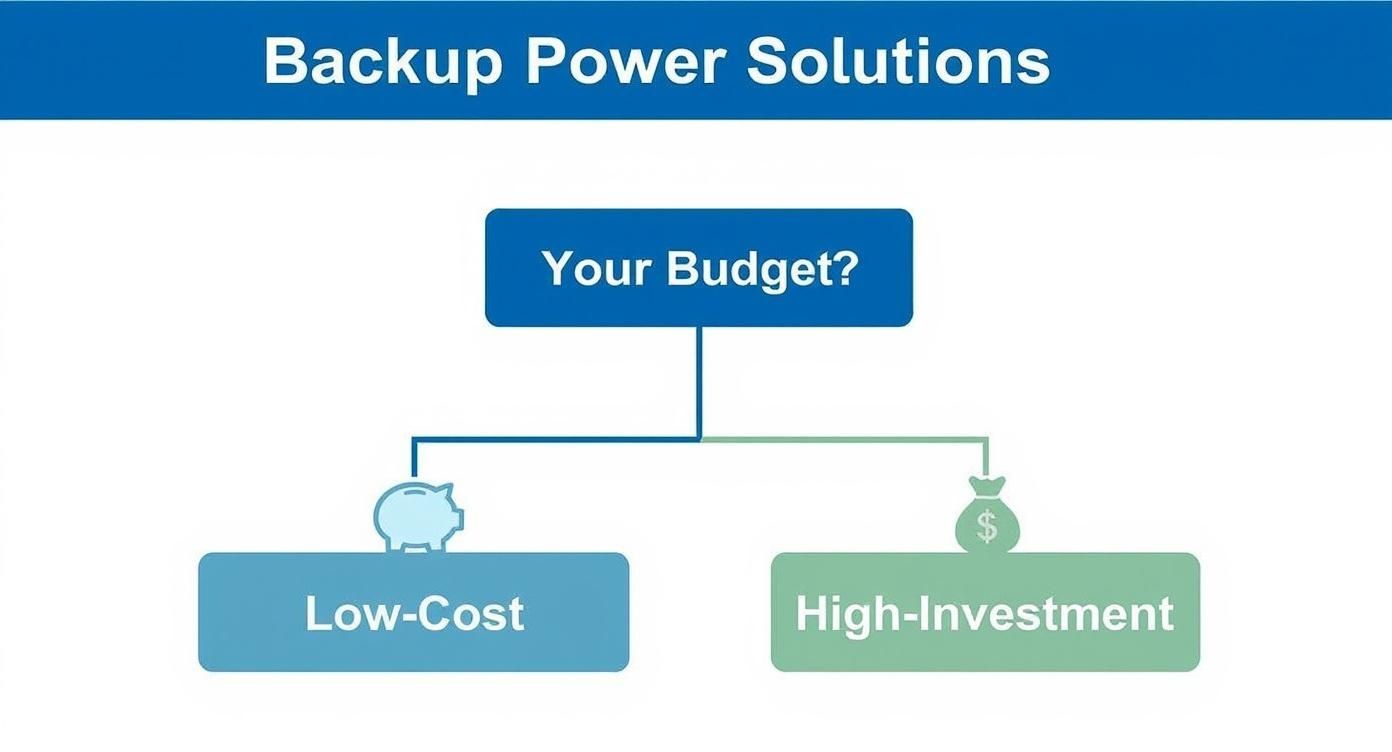
As you can see, what you're willing to invest is usually the first big fork in the road. It helps point you toward either a simpler, portable unit or a more permanent, integrated system.
Recommendations for Common Scenarios
Once you've got your answers, you can start to see which type of system lines up with your profile. Most people fall into one of these three camps:
The Budget-Conscious Homeowner: If your main priority is just keeping the absolute basics running during a short outage without a huge upfront cost, a portable generator is almost always the answer.
The Tech-Focused Prepper: For someone who wants silent, instantaneous power from a clean source—and maybe wants to add solar panels down the line—a home battery system is the perfect fit.
The Set-It-and-Forget-It Family: If you want zero-effort, powerful, whole-home backup that can handle long outages without you lifting a finger, nothing beats the peace of mind of a standby generator.
With this clear picture of your needs, you're in a great position to start talking to professionals, getting quotes, and making that final choice with confidence.
Got Questions About Backup Power? We've Got Answers.
Even after laying out all the options, a few questions always pop up. It's completely normal. Let's tackle some of the most common things homeowners ask when they're trying to pick the right home backup power solution.
How Long Will a Backup System Actually Keep My Lights On?
This is the big one, isn't it? The honest answer is: it depends entirely on the system you choose. Think of it as two totally different approaches to keeping the power flowing.
- Fuel-Based Systems: With a generator, your runtime is really only limited by how much fuel you have on hand. As long as you can safely top it up with gasoline, propane, or natural gas, that machine can hum along for days, sometimes even weeks. This is why they're so popular in places that get hit with long, drawn-out outages.
- Energy Storage Systems: Home batteries are a different beast. Their power is defined by their storage capacity, which we measure in kilowatt-hours (kWh). A fully charged battery might get your essential appliances through a few hours or even a full day. But here's the magic part: when you connect them to solar panels, they can recharge every single day, giving you a potentially endless supply of clean power.
Here’s a quick way to think about how long each system can last.
| System Type | What Limits Its Runtime? | How Long Can It Go? |
|---|---|---|
| Generator | Access to Fuel | Potentially Indefinite (as long as you can refuel) |
| Battery System | Stored kWh Capacity & A Way to Recharge | Hours to Days (can be extended indefinitely with solar) |
Can I Install This Myself?
The installation process can be anything from a simple five-minute task to a complex project that you should absolutely not try yourself.
For a small, portable generator, setup is a breeze. You just wheel it outside to a safe spot (away from windows!) and run some heavy-duty extension cords to your fridge or freezer. Easy peasy.
However, once you start talking about systems that tie directly into your home's main electrical panel, this is no longer a DIY job. This is where you call in the pros. This includes:
- Standby Generators: You'll need a licensed electrician to handle the automatic transfer switch and a certified plumber to connect the fuel line.
- Home Battery Systems: These have to be wired into your electrical system by a certified installer. It’s crucial for safety and for meeting local building codes.
Let me be blunt: trying to install a permanently wired system yourself is incredibly dangerous. You risk fire, electrocution, and you'll almost certainly void your equipment warranty and maybe even your homeowners insurance. Always hire a qualified professional.
Will a Backup System Add Value to My House?
Yes, it absolutely can. A permanently installed backup power system is a huge selling point, especially in areas where the grid is a bit shaky. Having a standby generator or a solar-plus-battery system can make your home far more attractive to potential buyers.
In fact, research has shown that homes with these kinds of resilience upgrades often see a real bump in their resale value. Buyers see it as a premium feature that provides security and peace of mind, making your property the one they remember. It's an investment that not only protects your family now but can pay you back when it’s time to sell.
Ready to make sure your home's lights stay on, no matter what? The experts at Radiant Energy can help you figure out the perfect solar and battery backup system for your specific needs. It's time to take control of your power.
Learn more about our energy storage solutions at radiantenergysolar.com

